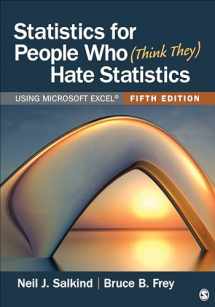
Statistics for People Who (Think They) Hate Statistics: Using Microsoft Excel
Book details
Summary
Description
This Fifth Edition of Neil J. Salkind's Statistics for People Who (Think They) Hate Statistics: Using Microsoft Excel, presents an often intimidating and difficult subject in a way that is clear, informative, and personable. Opening with an introduction to Excel, including coverage of how to use functions and formulas, this edition shows students how to install the Excel Data Analysis Tools option to access a host of useful analytical techniques. New to the Fifth Edition is new co-author Bruce Frey who has added a new feature on statisticians throughout history (with a focus on the contributions of women and people of color). He has updated the "Real-World Stats" feature, and added more on effect sizes, updated the discussions on hypotheses, measurement concepts like validity and reliability, and has more closely tied analytical choices to the level of measurement of variables.


We would LOVE it if you could help us and other readers by reviewing the book
Book review



